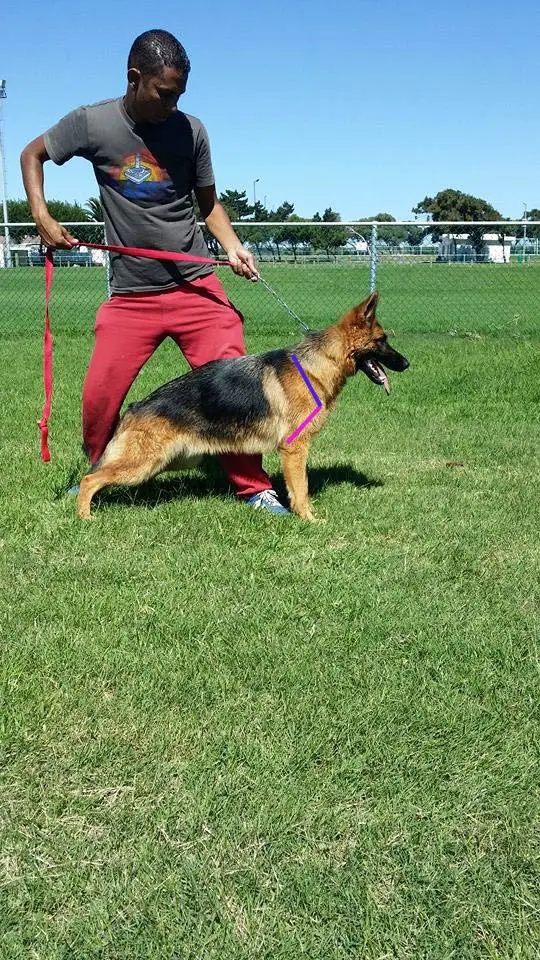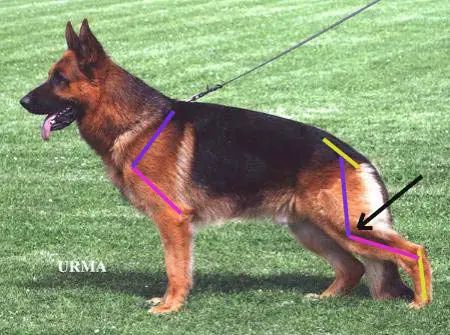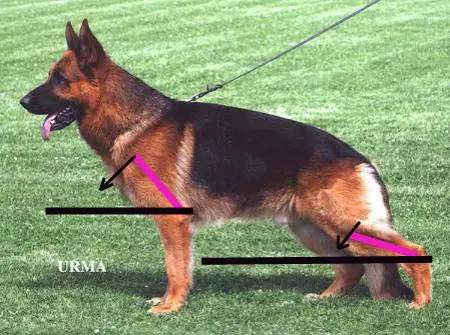
This is a placeholder text
Group text
by Ibrahim on 24 March 2014 - 23:03
Waleed,
I don't see how I could explain it in a diagram, I will try to explain it in words.
When experts describe a German Shepherd Dog body as well balanced they are in fact describing two things:
1. It has correct proportions, that is height to body length and arm to total height.
2. Equally good front and hind angulations.
In case of your dog, her front angulation does not complement her rear angulation. Front upper arm slightly lacks in length and angulation, and will not be able to make a front reach to cope with the under reach made by rear leg.
Why is it necessary for a trotter to have balance/symmetry of both front an rear angulations?
Force of movement is generated from rear, then transmitted through croup to the spine towards the front. Rear legs work as starters and front legs work as followers.
A well angulated dog in the rear would have a good under reach and would generate a good forward thrust. A well angulated dog in the front would receive this momentum from the rear and extend its fore leg enough to absorb and make full use of the forward thrust delivered in order to cover maximum ground.
In case of a dog that has more angulation in the rear than in the front, optimum balance is missing, harmoney between rear and front legs in a trot would not be best, such a dog when well practiced in trot shall find a way to tune his rear and front movement, this will result ultimately in less fluid movement and a sooner fatigue/less endurance in long trots. When in a show and pushed into fast trot for long periods other competitor dogs of better balance would last longer be it of more or leass angulations, but balanced.
Sometimes when a dog's rear angulation vastly supercedes its front, dog starts buying time by moveing his front legs up in the air.
However, this discussion should not lead you to think your dog is less than it really is. We, here, are discussing her versus perfection. Even VA dogs are not 100% perfect.
Hopefully that is clear enough
Ibrahim
I don't see how I could explain it in a diagram, I will try to explain it in words.
When experts describe a German Shepherd Dog body as well balanced they are in fact describing two things:
1. It has correct proportions, that is height to body length and arm to total height.
2. Equally good front and hind angulations.
In case of your dog, her front angulation does not complement her rear angulation. Front upper arm slightly lacks in length and angulation, and will not be able to make a front reach to cope with the under reach made by rear leg.
Why is it necessary for a trotter to have balance/symmetry of both front an rear angulations?
Force of movement is generated from rear, then transmitted through croup to the spine towards the front. Rear legs work as starters and front legs work as followers.
A well angulated dog in the rear would have a good under reach and would generate a good forward thrust. A well angulated dog in the front would receive this momentum from the rear and extend its fore leg enough to absorb and make full use of the forward thrust delivered in order to cover maximum ground.
In case of a dog that has more angulation in the rear than in the front, optimum balance is missing, harmoney between rear and front legs in a trot would not be best, such a dog when well practiced in trot shall find a way to tune his rear and front movement, this will result ultimately in less fluid movement and a sooner fatigue/less endurance in long trots. When in a show and pushed into fast trot for long periods other competitor dogs of better balance would last longer be it of more or leass angulations, but balanced.
Sometimes when a dog's rear angulation vastly supercedes its front, dog starts buying time by moveing his front legs up in the air.
However, this discussion should not lead you to think your dog is less than it really is. We, here, are discussing her versus perfection. Even VA dogs are not 100% perfect.
Hopefully that is clear enough
Ibrahim
by sunshine on 25 March 2014 - 03:03
I like her. Have you measured her? How is her temperament and have you done any health tests suc as hips and elbows. If she were my female and had this, I would forge ahead with her. Overlall a nice young female. She looks to have some spunk in her. Good luck and keep the pics coming.
by Ibrahim on 25 March 2014 - 09:03
Waleed,
Here are the bones ( front upper arm & shoulder blade) which constitute the shoulder, the way they are set and joined together make the shoulder angulation ( angulation means bones length proportions plus angle inbetween)
The below pink line represents the front upper arm and blue line is the shoulder blade, I drew them in the way a judge imagines them when looking at a dog's shoulder angulation, same way you would visualize them when you feel them with your fingers. Just a side note here but don't dwell on it, correct lines that represent actual angulation should be those that pass through centers of bones from and to joints. But for easiness of explanation we will adopt this representation at this time.
.jpg)
Notes:
1. When the pink line is equal in length to blue line or slightly more, the upper arm is said to be long.
2. The smaller the angle inbetween pink and blue lines, the better is the shoulder angulation. Theoretically this angle should be close to 90 degrees.
Here are the bones ( front upper arm & shoulder blade) which constitute the shoulder, the way they are set and joined together make the shoulder angulation ( angulation means bones length proportions plus angle inbetween)
The below pink line represents the front upper arm and blue line is the shoulder blade, I drew them in the way a judge imagines them when looking at a dog's shoulder angulation, same way you would visualize them when you feel them with your fingers. Just a side note here but don't dwell on it, correct lines that represent actual angulation should be those that pass through centers of bones from and to joints. But for easiness of explanation we will adopt this representation at this time.
.jpg)
Notes:
1. When the pink line is equal in length to blue line or slightly more, the upper arm is said to be long.
2. The smaller the angle inbetween pink and blue lines, the better is the shoulder angulation. Theoretically this angle should be close to 90 degrees.
by waleed786 on 25 March 2014 - 09:03
@ khaleed thanks u my brother, i'll surely be working on my stacking her correctly.
@ sunshine we wil be doing her hips and elbows next month. She has super super drive and loves bite work. There was a time for about 4 months where i never did any bite/drive work with her due to personal isues and work besides taking her for her regular walk. Then the other day i took out the sausage and arm and it's like bite/drive work is in her blood she just goes and goes. I'll try and post pics and a video in future.
@ ibrahim i really value you opinion and that is why i love this website. I now somehow understand what u said. I would assume that this is what people refer when they say 'she is falling on her arm'? I would guesss this is because of the power coming from her rear? Can u on my pic i posted maybe draw a line or show how the upper arm should look like as well as her rear angulation that u refer to be good. I appreciate your time and i am gratefull for what you have shown this newbie thus far!
@ sunshine we wil be doing her hips and elbows next month. She has super super drive and loves bite work. There was a time for about 4 months where i never did any bite/drive work with her due to personal isues and work besides taking her for her regular walk. Then the other day i took out the sausage and arm and it's like bite/drive work is in her blood she just goes and goes. I'll try and post pics and a video in future.
@ ibrahim i really value you opinion and that is why i love this website. I now somehow understand what u said. I would assume that this is what people refer when they say 'she is falling on her arm'? I would guesss this is because of the power coming from her rear? Can u on my pic i posted maybe draw a line or show how the upper arm should look like as well as her rear angulation that u refer to be good. I appreciate your time and i am gratefull for what you have shown this newbie thus far!
by Ibrahim on 25 March 2014 - 09:03
For a comparison of shoulder qualities, let us use the dog Sunsilver used in her above post.
Please note that lines of bones are drawn in same principle I explained above and as I personally see them, another person who has experienced eye might see them a bit different but there wouldn't be a much of difference in actual angulation.
.jpg)
Olease note: pink line is same length of blue line. Angle inbetween is close to 90 degrees.
Look at your dog's shoulder bones as I see them

Please note:
1. Pink line is slightly shorter than the blue line, in picture it may not look its true value but on actual body of dog it would look more visible.
2. Angle inbetween is more open than that of Sunsilver's example.
3. This should not take away from the quality of your dog, remember we are comparing her to a dog that was rated VA in Germany.
Please note that lines of bones are drawn in same principle I explained above and as I personally see them, another person who has experienced eye might see them a bit different but there wouldn't be a much of difference in actual angulation.
.jpg)
Olease note: pink line is same length of blue line. Angle inbetween is close to 90 degrees.
Look at your dog's shoulder bones as I see them

Please note:
1. Pink line is slightly shorter than the blue line, in picture it may not look its true value but on actual body of dog it would look more visible.
2. Angle inbetween is more open than that of Sunsilver's example.
3. This should not take away from the quality of your dog, remember we are comparing her to a dog that was rated VA in Germany.
by Ibrahim on 25 March 2014 - 10:03
Here is more comparison between various shoulders
.jpg)
.jpg)
by Ibrahim on 25 March 2014 - 10:03
To compare her rear angulation
look at the angle between the pink and blue line

.jpg)
Please note that her knee is turning to the out in the way she is stacked, pink line is represented to best I could.
look at the angle between the pink and blue line

.jpg)
Please note that her knee is turning to the out in the way she is stacked, pink line is represented to best I could.
by waleed786 on 25 March 2014 - 10:03
My friend Ibrahim , i say thank you !
by Ibrahim on 25 March 2014 - 11:03
I will also tell you a tip how to tell angulation of rear and front in a simple approximate method
by Ibrahim on 25 March 2014 - 12:03
Imagine the path of lower thigh bone, imagine the path of front upper arm, the closer those two lines (pink) to the horizontal (black) , the more angulation, in front the closer always the better, in rear the closer the better to a certain limit, beyond this limit the more is not the better as it shall cause the dog to land on the bone of hock when in full under reach instead of landing on the pads of feet. It will also cause extra unfavorable pressure on the hip joint, remember the upper thigh bone rotates in the hip and is supported in under and outer reach by two muscles, one on front of the bone, another on back of the bone, those two muscles would undergo more fatigue in case of over rear angulation and in case of relatively long lower thigh bone. A long lower thigh bone which works as a lever gets weaker when longer, thus is the sideways walk in rear, simply called loose rear.


Contact information Disclaimer Privacy Statement Copyright Information Terms of Service Cookie policy ↑ Back to top




